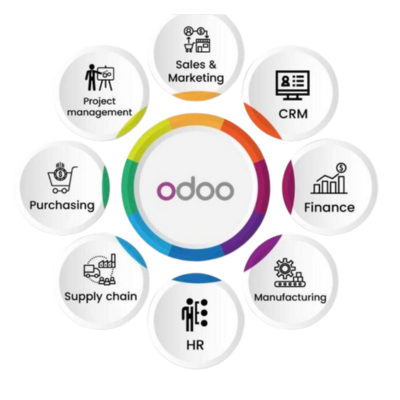How Orchest and Odoo Enable Seamless Integration
Orchest’s and Odoo’s integration empowers businesses by offering a robust system for connecting, managing, and automating business processes.

1. Centralized Data Integration
- Orchest simplifies the movement of data between systems, allowing users to create automated pipelines to share data with Odoo applications.
- Odoo then uses this data across its modules—such as CRM, Sales, Inventory, and Accounting—to build a cohesive business ecosystem.
Example: Data from customer relationship management (CRM) can flow seamlessly into sales and accounting modules, providing real-time insights into the customer journey, purchase patterns, and revenue metrics.
2. Advanced Automation Capabilities
- Orchest provides tools to design custom workflows that automatically update data within Odoo’s applications, reducing manual work.
- Automation allows for repetitive tasks like invoicing, report generation, and inventory updates to occur without human intervention, enhancing both productivity and accuracy.
3. Real-Time Business Insights
- Orchest integrates data across departments, while Odoo’s dashboards present it in a digestible format, enabling decision-makers to make informed, timely decisions.
- This synergy enhances the ability to monitor key performance indicators (KPIs) and adapt quickly to business demands.
Key Features of the Orchest-Odoo Integration
The integration between Orchest and Odoo offers several distinct features that amplify their combined potential:
Feature | Benefit | Impact |
Automated Workflows | Streamlines processes and reduces errors | Increases operational speed |
Real-Time Data Sync | Ensures up-to-date data across all Odoo modules | Enhances data accuracy |
Customizable Dashboards | Provides tailored insights for different departments | Improves decision-making |
Low-Code Integration | Empowers non-technical users to manage data connections | Increases accessibility |
Scalable Infrastructure | Adapts to growing business data needs | Future-proofing |
Use Cases: Realizing Business Potential Through Connectivity

Orchest and Odoo’s joint capabilities have the power to transform operations across various industries.
1. E-commerce Businesses
- Challenge: Managing customer data, orders, and inventory can be overwhelming, especially as businesses scale.
- Solution: Orchest automates data collection from multiple e-commerce platforms, while Odoo organizes and syncs this data across CRM, Inventory, and Sales.
- Impact: Reduced lead times, real-time inventory tracking, and improved customer satisfaction.
2. Manufacturing Companies
- Challenge: Coordinating supply chains, production, and distribution requires constant data updates.
- Solution: Orchest streams real-time data from suppliers and distributors, while Odoo manages and tracks production and inventory.
- Impact: Efficient production scheduling, minimized stockouts, and streamlined supply chain operations.
3. Financial Services
- Challenge: Financial data management and reporting require precision and consistency.
- Solution: Orchest organizes financial datasets from various sources, while Odoo consolidates them in accounting modules for reporting.
- Impact: Enhanced financial oversight, faster report generation, and improved compliance.
Benefits of Using Orchest and Odoo Together
Implementing Orchest and Odoo as an integrated solution brings measurable benefits:
- Enhanced Productivity – With automated workflows and centralized data, employees focus on strategic tasks rather than manual data handling.
- Better Customer Insights – By pooling data across departments, companies get a 360-degree view of the customer journey.
- Increased Flexibility – Businesses can customize workflows to their specific needs and adapt workflows quickly as they grow.
- Improved Scalability – Both Orchest and Odoo support scaling, making it easier to handle large volumes of data and complex processes.
Statistically, companies that effectively implement data integration experience a 29% reduction in operational costs and a 34% increase in productivity.
Challenges and Considerations
While the Orchest-Odoo integration offers considerable advantages, companies need to consider a few key factors for successful implementation:
- Data Security: Ensuring data security is crucial, especially when integrating across multiple platforms.
- Customization Needs: Each business has unique workflows; adapting Orchest and Odoo to these needs may require expertise.
- Resource Allocation: Dedicated resources are essential for setup, training, and maintenance to leverage the integration fully.
Expert Odoo ERP Solutions Provider
Hire Expert Odoo Developers for Tailored ERP Solutions Today!

Conclusion: A New Era of Business Connectivity
The combined strength of Orchest’s data orchestration with Odoo’s modular applications brings business connectivity to a new level. Together, they provide a seamless, efficient, and scalable solution that bridges the gap between isolated systems and unified operations.
Whether an organization is in retail, manufacturing, finance, or any other sector, the Orchest-Odoo integration offers a path toward better productivity, improved data visibility, and agile business operations. This partnership is transforming how businesses operate, empowering them to make data-driven decisions in real time and grow in a digitally connected world.
FAQs
What are Orchest’s main features?
Orchest offers features like:
- Visual workflow design
- Integration with different tools (e.g., Python, SQL, Docker)
- Real-time monitoring and debugging
- Automated scheduling and execution of workflows
- Open-source, making it customizable and adaptable for different business needs
How does Orchest benefit data teams?
Orchest improves collaboration between data teams, increases the efficiency of data workflows, and reduces the chances of errors by automating repetitive tasks. It also offers the flexibility to scale and integrate with other tools, which is important for evolving business needs.
Is Odoo customizable for different industries?
Yes, Odoo is highly customizable, offering over 30 core modules that can be tailored for different industries. Additionally, there are thousands of third-party modules available, allowing businesses to adapt Odoo to their unique needs.
What makes Odoo different from other ERPs?
Odoo stands out because it offers a fully integrated suite of applications, ranging from accounting to eCommerce. Unlike some ERPs, which may require third-party integrations for additional functionalities, Odoo provides a comprehensive system out of the box. Its modular approach means businesses can scale by adding only the modules they need.
Can Orchest and Odoo be used together?
Yes, Orchest and Odoo can complement each other. Orchest could be used for data automation tasks (such as data pipeline management), while Odoo could manage the broader business operations. Integrating the two platforms can help create more efficient workflows across different departments, with Orchest automating data workflows and Odoo handling business processes.















